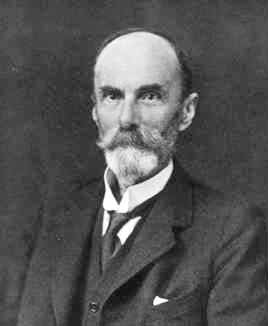
Francis Sowerby Macaulay
 المؤلف:
T A A Broadbent
المؤلف:
T A A Broadbent
 المصدر:
Biography in Dictionary of Scientific Biography
المصدر:
Biography in Dictionary of Scientific Biography
 الجزء والصفحة:
...
الجزء والصفحة:
...
 17-3-2017
17-3-2017
 778
778
Born: 11 February 1862 in Witney, England
Died: 9 February 1937 in Cambridge, Cambridgeshire, England

Francis Macaulay's father, the Rev Samuel Macaulay, was a Minister in the Methodist Church. He sent his son Francis to a school for the sons of Methodist Ministers in Bath, namely Kingswood School. Graduating from Kingswood School in 1879, Macaulay entered St John's College, Cambridge, from which he graduated with distinction, being eighth Wrangler (ranked eighth in the list of First Class students) in the Mathematical Tripos of June 1882. In January of the following year he was placed seventh in the advanced papers of the Tripos.
Francis Macaulay was not the only member of his family who excelled at mathematics. H F Baker writes [4]:-
A brother, familiarly known to his contemporaries at Cambridge in 1886 as "Macaulay of Caius", was remarkable for his devotion to the theory of quaternions, and had a successful career as Professor of Mathematics in the antipodes.
After graduating from Cambridge, Macaulay returned to Kingswood School in Bath in 1883, where he himself had studied, and taught mathematics there for two years. He then went to London in 1885, becoming a teacher at St Paul's School. In this school he taught the top mathematical class, which often contained outstanding pupils, and he encouraged them into a research career in mathematics, particularly at Cambridge. Two such students were Watson and Littlewood and we know of the teaching methods employed by Macaulay through the writing of Littlewood [1]:-
... [T]here was little formal instruction; students were directed to read widely but thoroughly, encouraged to be self-reliant, and inspired to look forward to pursuing research in mathematics.
Littlewood consulted the examinations record and wrote in [4]:-
In the 25 years from [Macaulay's] appointment to St Paul's in 1885 to his resignation in 1911 there were 41 scholarships (34 at Cambridge) and 11 exhibitions; and in the 20 years available there were 4 senior wranglers, one second, and one fourth among his former pupils.
Macaulay married in 1923 [2]:-
Norah, widow of Mr G A Matthew, of Cambridge.
He wrote 14 papers on algebraic geometry and polynomial ideals. The papers look at algebraic curves, the Riemann-Roch theorem and algebraic polynomials. It is important pioneering work in the development of algebraic geometry. In 1915 Macaulay discovered the primary decomposition of an ideal in a polynomial ring, which is the analogue of the decomposition of a number into a product of prime powers. This work was independent of that done by Lasker in 1905.
The passage of time since Macaulay published The algebraic theory of modular systems in 1916 has shown us what a remarkable work this is in the development of modern mathematics. The book has recently been reissued, eighty years after it was first published, not merely as an historical document but also because Macaulay's ideas are still highly relevant to present day research.
What ideas were there then in this work? The main theme underlying the book is the problem of solving equations of systems of polynomials in several variables. Such problems have no complete solution, but Macaulay looks for structural properties of the set of solutions. In other words, in today's terminology, he is examining ideals in polynomial rings. This leads Macaulay to study Lasker's decomposition of ideals into primary ideals (the analogue of the decomposition of an integer into prime powers) and he also looks at properties which today surround the theory of Gröbner bases.
Littlewood writes in [4]:-
No one in England knew about his subject, and I believe he was very little in touch with workers abroad: he never spoke of his work, did not expect recognition in his life-time, and even when he was put up for the Fellowship of the Royal Society did not expect to be elected. In this, of course, he exaggerated, and his election gave him profound pleasure.
Where have Macaulay's ideas led in today's mathematics? Well the ideas in this book have led to ideal theory studied by Krull (see W Krull, Idealtheorie, Berlin, 1935), to Cohen-Macaulay rings, so named by Zariski and Samuel (see O Zariski and P Samuel, Commutative Algebra, Princeton, NJ, 1958), the notion of perfectness (studied in W Gröbner, Moderne algebraische Geometrie, Vienna, 1949), and to the notion of Gorenstein rings.
We should also note that Macaulay was an associate editor of the Mathematical Gazette for many years. He also contributed a number of articles: Bolyai's science of absolute space (1900), On continued fractions (1900), Projective geometry (1906), On the axioms and postulates employed in the elementary plane constructions (1906), On a problem in mechanics and the number of its solutions (1906), and Some inequalities connected with a method of representing positive integers (1930).
Macaulay retired from St Paul's School in 1911 and after World War I he moved from London to live in Cambridge. Baker writes [4]:-
... one remembers with admiration the bravery with which, in his last years, he sought to continue his normal activities - as, for instance, by travelling out to the golf links to play a strictly limited number of holes before lunch.
- T A A Broadbent, Biography in Dictionary of Scientific Biography (New York 1970-1990).
http://www.encyclopedia.com/doc/1G2-2830902721.html
Articles:
- H F Baker, Francis Sowerby Macaulay, J. London Math. Soc. 13 (1938), 157-160.
- H F Baker, Francis Sowerby Macaulay, Obituary Notices of Fellows of the Royal Society of London II (1936-38), 357-361.
 الاكثر قراءة في 1860to1864
الاكثر قراءة في 1860to1864
 اخر الاخبار
اخر الاخبار
اخبار العتبة العباسية المقدسة


